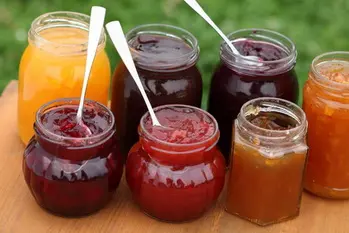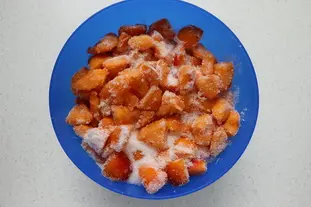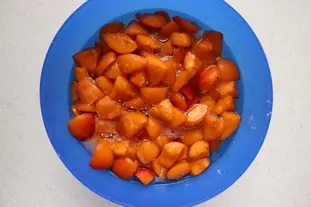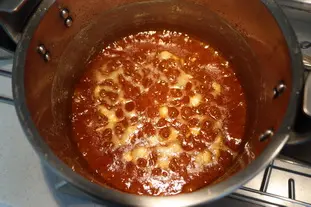This site uses only a few technical cookies necessary for its operation. By continuing to browse, you accept their use.
To find out more...
To find out more...
The time of the jams

We are well into summer as I write this, and this is the time when most of the fruit is giving or about to give in full.
And for many of us, it will also be the time for jams and jellies, one of the best ways to preserve fruit for the next winter.
And for many of us, it will also be the time for jams and jellies, one of the best ways to preserve fruit for the next winter.
27 K 4.5/5 (23 reviews)
Keywords for this post:JamJellySummerFruitSugarGelling agentSyrupLast modified on: July 12th 2021
The time of the jams
In principle, jam is very simple, you mix sugar and fruits in variable proportions, and you cook it until it thickens.
For jelly, it's the same except that instead of fruit you use fruit juice or pulp only.
It is necessary to start well the process and not to make a mistake, good jam = beautiful fruits at the beginning, it would be a mistake to use fruits a little neutral in taste, or a little spoiled, thinking that in the jam it will pass.
It's almost the opposite, you need very nice/good fruits to make a very good jam.
Later, when you prepare your fruits, systematically eliminate all the spoiled or weak parts, you must keep only the best of the fruits.
The more sugar you put in, the more easily it takes, but the less it tastes like fruit.
Commercial jams, for example, are generally very sweet, probably too much so, because sugar is much cheaper than fruit, and it's a question of money as usual.
A 50% fruit 50% sugar is already very good, but at home you can reduce it to 40% sugar (the ideal rate for me).
This sugar rate is also a question of taste, but also of time, jams now are much less sweet than in the past, and it's a good thing, an apricot jam for example, should have a very clear apricot taste, and not a sweet taste with an apricot background.
You can cook the sugar/fruit mixture directly, adding a little water to thin it out, but this is not a very good option as the water will have to be boiled off afterwards.
There is a much better solution, which I already told you about in a previous article, which is to put the chopped fruits and the sugar together for at least 4 hours, or one night, and the whole thing forms a syrup (the hygroscopic side of the sugar) which can be cooked directly.
To obtain a jam, it is a mixture which thickens, just enough...
To obtain this thickening, there are 2 ways :
- The old way, used by our grandmothers, which consists in cooking the mixture, (very) long to bring the sugar to 110°C, temperature where it thickens the whole mixture.
- The more modern way is to use a gelling agent: pectin, agar-agar, gelatine... which are active at 100°C or even lower.
The old method, long cooking, which may seem "natural", has the big defect of reducing the taste of fruits, especially with delicate fruits like strawberries for example.
The new method allows a short cooking, we bring to boil, we add the gelling agent (the famous"Vit'pris" in France which is apple pectin) and after 2 or 3 minutes of boiling the jam is ready.
As for me, I'm an unconditional fan of the use of the gelling agent, pectin, which is neutral in taste, and it's very efficient to make a good jam or jelly.
Once the jam is ready, you have to put it in a jar, it is not very complicated, but it is very important to make sure that the inside of the jar remains sterile.
And for that, there is a very effective trick: Pour the burning jam in the jar, close it and turn it upside down (take gloves), wait 1 minute, then put it back.
By doing this, the air in the jar will pass through the burning jam and become sterilized, so you will have jam jars that can easily be kept for several months, and out of the fridge.
Here are some tracks for your future jams, can you enjoy the beautiful fruits of the summer to come.
To sum up: For good jams, choose beautiful fruits, make a syrup, cook a little (with a gelling agent), and sterilize your jars by turning them over.
For jelly, it's the same except that instead of fruit you use fruit juice or pulp only.
Some important points
The quality of the fruits

It is necessary to start well the process and not to make a mistake, good jam = beautiful fruits at the beginning, it would be a mistake to use fruits a little neutral in taste, or a little spoiled, thinking that in the jam it will pass.
It's almost the opposite, you need very nice/good fruits to make a very good jam.
Later, when you prepare your fruits, systematically eliminate all the spoiled or weak parts, you must keep only the best of the fruits.
The sugar-fruit ratio
The more sugar you put in, the more easily it takes, but the less it tastes like fruit.
Commercial jams, for example, are generally very sweet, probably too much so, because sugar is much cheaper than fruit, and it's a question of money as usual.
A 50% fruit 50% sugar is already very good, but at home you can reduce it to 40% sugar (the ideal rate for me).
This sugar rate is also a question of taste, but also of time, jams now are much less sweet than in the past, and it's a good thing, an apricot jam for example, should have a very clear apricot taste, and not a sweet taste with an apricot background.
The syrup


You can cook the sugar/fruit mixture directly, adding a little water to thin it out, but this is not a very good option as the water will have to be boiled off afterwards.
There is a much better solution, which I already told you about in a previous article, which is to put the chopped fruits and the sugar together for at least 4 hours, or one night, and the whole thing forms a syrup (the hygroscopic side of the sugar) which can be cooked directly.
Thickening

To obtain a jam, it is a mixture which thickens, just enough...
To obtain this thickening, there are 2 ways :
- The old way, used by our grandmothers, which consists in cooking the mixture, (very) long to bring the sugar to 110°C, temperature where it thickens the whole mixture.
- The more modern way is to use a gelling agent: pectin, agar-agar, gelatine... which are active at 100°C or even lower.
The old method, long cooking, which may seem "natural", has the big defect of reducing the taste of fruits, especially with delicate fruits like strawberries for example.
The new method allows a short cooking, we bring to boil, we add the gelling agent (the famous"Vit'pris" in France which is apple pectin) and after 2 or 3 minutes of boiling the jam is ready.
As for me, I'm an unconditional fan of the use of the gelling agent, pectin, which is neutral in taste, and it's very efficient to make a good jam or jelly.
The sterilization


Once the jam is ready, you have to put it in a jar, it is not very complicated, but it is very important to make sure that the inside of the jar remains sterile.
And for that, there is a very effective trick: Pour the burning jam in the jar, close it and turn it upside down (take gloves), wait 1 minute, then put it back.
By doing this, the air in the jar will pass through the burning jam and become sterilized, so you will have jam jars that can easily be kept for several months, and out of the fridge.
Here are some tracks for your future jams, can you enjoy the beautiful fruits of the summer to come.
To sum up: For good jams, choose beautiful fruits, make a syrup, cook a little (with a gelling agent), and sterilize your jars by turning them over.
Lasts posts
Butter vs. grease
We often read in a recipe where a pastry is put into a mould that, just before pouring, the mould should be buttered or greased. But what's the difference between these 2 terms?December 1st 20251,0015
Getting out of the fridge early
Very often when you're cooking, you need to take food or preparations out of the fridge, to use them in the recipe in progress. There's nothing tricky about this: you just take them out of the fridge and use them, usually immediately, in the recipe. But is this really a good method?November 24th 20251,1305
Who's making the croissants?
When you look at a bakery from the outside, you naturally think that in the bakery, the bakers make the bread, and in the laboratory, the pastry chefs make the cakes. It's very often like that, with each of these professions having quite different ways of working, but sometimes there's also one...November 23th 20251,021
Oven height
When we put a dish or cake in the oven, we naturally tend to put it on the middle shelf, and that's what we usually do. But in some cases, this position and height can be a little tricky, so let's find out why.October 8th 20252,7695
The importance of sieving
In recipes that use a fine powder (flour, powdered sugar, etc.), you'll often see the advice to sift before using it. To sift is to pass the powder in question through a sieve (a very fine strainer) before incorporating it into your recipe. It's often advice, but is it really useful?September 3rd 20257,5383
Other pages you may also like
The power of sayings and beliefs in the kitchen
One day, in the comments on the recipe for beaten egg whites, a young woman asked if you could beat egg whites stiff while having a period, as a friend had told her it wasn't possible. Sometime later another person commented that for mayonnaise it had been (get this!) scientifically proven that a...February 6th 201152 K4.4
Fruits which can ruin your jelly
There are many ways of making a fruit mousse, but one of the simplest is to prepare a fruit jelly (basically a fresh fruit coulis with gelatine) and then mix this jelly before it sets completely with whipped cream. The result is perfect for filling a charlotte, for example. But do beware;...March 6th 201378 K4.0
Rosemary in recipes
Rosemary, as I’m sure you know, is a culinary herb, one of the famous French "herbes de Provence", and is very effective in bringing a real taste of the Mediterranean to any dish. The classic way to use it in a recipe is to add a sprig or two and leave it in during cooking as a way of...April 18th 201824 K4.7
Herbs and temperature
I have already talked to you about herbs in cooking, and about their great power of "seduction". The example of a salad is a great classic: on its own, it's a salad, which is normal, but the same salad in which you have added finely chopped fresh herbs, just before serving, you have much more than a...April 25th 202011 K4.8
Should I believe my oven?
Can you really trust your oven? This is an important question as we are always tempted to take the temperature indicated as gospel truth and, unfortunately, this is rarely very precise. .July 4th 201133 K4.6
Post a comment or question
Follow this page
If you are interested in this page, you can "follow" it, by entering your email address here. You will then receive a notification immediately each time the page is modified or a new comment is added. Please note that you will need to confirm this following.
Note: We'll never share your e-mail address with anyone else.
Alternatively: you can subscribe to the mailing list of cooling-ez.com , you will receive a e-mail for each new recipe published on the site.









